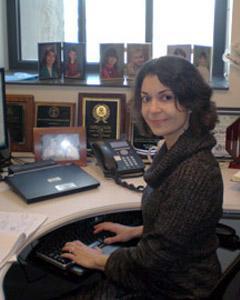Meet EPA Scientist Valerie Zartarian, Ph.D.

Using Innovative Research to Help Protect Human Health
Senior exposure scientist and research environmental engineer Valerie Zartarian, Ph.D. helps build computer models and other tools that advance our understanding of how people interact with chemicals.
The work she does provides communities and decision makers with the information they need to make decisions that protect human health.
How does your science matter?
The science I work on provides EPA and the public with information to improve human health and well-being.
My colleagues and I have developed and applied a computer model, called SHEDS (that's short for: Stochastic Human Exposure and Dose Simulation model), that simulates how people contact chemicals in the environment from everyday activities: breathing, eating, touching surfaces, and putting their hands or other objects in their mouths. This human exposure modeling research supports the Agency's risk assessments and regulatory decisions regarding residential pesticides and other toxic substances.
We've also been conducting community-level exposure research for assessing risks from various environmental pollutants. Our web-based mapping tools, C-FERST (Community-Focused Exposure and Risk Screening Tool) and T(ribal)-FERST will provide EPA, communities, tribes, and other stakeholders with accessible information to prioritize and address local environmental health-related issues.
If you could have dinner with any scientist, past or present, who would it be and what would you like to ask them about?
There are so many to choose from! I'll go with Maria Mitchell, who became world famous for discovering a new comet, because she was truly a pioneer: first female U.S. astronomer, first woman elected to the American Academy of Arts & Science, and then to the American Association for the Advancement of Science, first professor at Vassar College, first internationally recognized female scientist.
I'm curious to ask about her quote, "How much science needs women." I would also ask about her experiences overcoming societal obstacles to reach her goals, and thank her for helping break career barriers for women by picking up a telescope.
What do you like most about your research?
My career has provided extraordinary opportunities to conduct innovative research and develop tools for the benefit of improving human health. I like that my research balances sound science, creativity, and practical use for the general public.
I've had the opportunity to interact with community stakeholders and to collaborate with top scientists in EPA's Office of Research and Development (ORD) and EPA's Regional and Program Offices. I'm truly in awe of my colleagues, and feel extremely grateful and proud to be a researcher with EPA.
When did you first know you wanted to pursue science?
Probably junior year of high school. My teachers were inspirational role models, and I enjoyed all of my classes. By senior year I was intrigued by practical applications of math and science, and started to think about engineering as a career path.
Tell us about your science/educational background.
I was valedictorian of a high school with an excellent math and science program. Being captain of the Canton High (MA) math team, which was New England champion for many years, was a formative experience for me. Because I was equally drawn to English and drama, I attended Princeton University to pursue an engineering degree along with a strong liberal arts education. My undergraduate dissertation involved refining global climate models.
After graduating Princeton with a B.S. in civil engineering, I worked for several years as a consultant with CDM (Camp Dresser & McKee, Inc.) in the water resources field, where I applied groundwater pollution models. That practical experience exposed me to the broader field of environmental engineering, so I attended Stanford University for a Masters degree.
My advisor was interested in understanding pesticide risks to children of migrant farm workers. I found this work fulfilling, and decided to stay on for a Ph.D.. Together we initiated the human exposure research program at Stanford. My doctoral dissertation topic on pesticide exposure modeling, which necessitated developing new videography methods to understand children's activity patterns, was unconventional for the civil and environmental engineering department, but launched me into the emerging field of human exposure science.
I joined EPA as a postdoctoral researcher in 1998; my graduate school work was timely for the new modeling program in the Agency's National Exposure Research Laboratory. My career path has evolved in ways I could not have imagined. I'm excited now to be co-leading the Community Public Health project in EPA's Sustainable and Healthy Community's research program.
What brought you to EPA?
I was introduced to human exposure science during graduate school by a former EPA scientist who was a founder of the field and a great mentor to me. One of my current EPA colleagues, who had helped me as a PhD student, encouraged me to apply for EPA's newly created postdoctoral research program in the Office of Research and Development (ORD).
If you were not a scientist, what do you think you would be doing?
That's a tough question for me, since I have many interests in both the arts and sciences. I really enjoy creative writing as a hobby, so I would probably try that professionally. As a mother of two, including a daughter with special medical needs, I could also envision doing something else related to children's health.
Any advice for students considering a career in science?
I would suggest taking a broad range of courses in scientific areas of interest. Doing internships to explore different fields is helpful to gain practical experience and focus career areas. I recommend gaining some consulting experience before pursuing graduate studies.
Once a student has established scientific expertise in a specific area, publishing in the peer-reviewed literature, staying current with the latest research, attending conferences, and taking training courses are important. Continually practicing technical writing and public speaking skills is critical for communicating science to various audiences.
